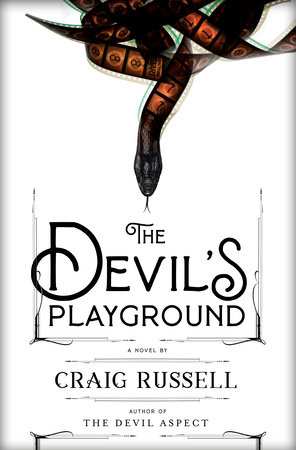The Devil’s Playground: A Novel
- By Craig Russell
- Doubleday
- 368 pp.
- Reviewed by Therese Droste
- August 1, 2023
A propulsive, eerie tale set during Hollywood’s Golden Age.

Scottish writer Craig Russell is a master of his craft. He is as prolific in his writing — having published almost one book every year since 2005 — as he is diligent with the historical details in his gothic horror and thriller novels. His most recent, The Devil’s Playground, may represent his pinnacle. Russell’s exhaustive research of Prohibition-era Hollywood brings to life silver-screen stars amid an atmosphere of corruption, murder, and voodoo that features Beelzebub himself.
There’s a lot going on in The Devil’s Playground. In this Hollywood, no one is as they seem, least of all Russell’s characters. He offers a complex cast and brilliantly weaves their backstories throughout the book as he takes the reader back and forth in time. In the hands of a lesser writer, the reader would be lost. But Russell’s storytelling is seamless.
The book opens — and, more critically, closes — in 1967 in the Mojave Desert with film historian Paul Conway. An anonymous client has paid him handsomely to find the only remaining copy of “The Devil’s Playground,” a 1920s silent film reputed to be the scariest horror movie ever made.
Conway drives through the inhospitable landscape to reach his destination: Hidden Lake, a manmade enclave in the middle of nowhere. It was built by a delusional financier who hoped to create a second Hollywood. Those hopes were buried when the lake dried up:
“It is a bizarre and intimidating sight: black and jagged, like some dark malignancy growing on the bleached skin of the desert… Christ, he thinks, it’s like a movie set.”
Such a “dark malignancy” not only permeates the book but, as certain truths unfold, seems to grow.
Forty years earlier, studio fixer Mary Rourke, known as the most connected person in Hollywood, is trying to solve the murder of Norma Carlton, the star of “The Devil’s Playground.” Unfortunately, the studio initially labeled the death a “natural causes” story and only later discovered it was indeed murder. This puts both Mary and the studio at risk of criminal charges themselves — for covering things up. Mary’s boss, Harry Carbine, realizing a murder could ruin his already financially tapped-out studio, sends her to find the killer.
Mary moves through the underworld of studio power and a corrupt Los Angeles Police Department as she digs into Norma’s death. Threatening incidents rattle even Mary, whose cynicism and toughness are hard-earned. Yet she is a strong protagonist with a noirish air who inspires hope that she’ll inevitably outwit her enemies.
At times, Russell’s taut dialogue and visual storytelling feel like watching a movie. (In fact, several of the novels in his German detective series, Jan Fabel, have either been made into movies or are in production.) The same descriptive skill comes to the fore when he introduces Kansas-born Boy Lindqvist in an 1897 storyline. Lindqvist runs away to join the Dahlman and Darke Magic Lantern Phantasmagoria circus after witnessing its sleight-of-hand act “where a dark shape spread itself wide. Revealed its true form.” That form was Satan. And Satan spoke to him.
The story also turns to Louisiana’s Bayou Leseuil in 1893 — and turns foreboding. Witch Hippolyta Cormier and her daughter Anastasie live in the swamp, and the locals believe Hippolyta has a “devil’s fingerprint” birthmark on her left cheek. Writes Russell:
“Out there, in the backswamp, the water slid sleek and black into darkening mists; pale wraiths of Spanish moss hung shroud like from the cypresses; the shadows were denser, fuller. At twilight and into the night, balls of light flitted through the swamp. The Cajuns called them fifollets and believed each light was the soul of a sinner.”
Part of the book’s intrigue derives from trying to unravel clues about which roles the characters from the past come to play in Hollywood. It’s not that Russell doesn’t drop hints — he does generously — but that he seems to know that even if you guess who’s who, it won’t temper the thrill of his fast-paced, intricate tale. It’s just that good.
All through the narrative, Russell refers to old movies that have been lost. One, the last known copy of the 1927 horror film “London After Midnight,” starring Lon Chaney — who also appears here — was destroyed in the 1965 MGM vault fire. He also tosses out a bit of humor, giving a hulking studio heavyweight the nickname Golem, a nod to Paul Wegener’s partially lost 1915 film.
Readers may feel a voyeuristic thrill as the names of Hollywood royalty — Clara Bow, John Barrymore, and Mary Pickford, among others — are dropped into scenes. Indeed, Tinseltown aficionados and fans of the likes of James Ellroy and Raymond Chandler will devour The Devil’s Playground, as will any reader who appreciates a tightly plotted, propulsive story filled with multilayered characters. Your only complaint may be that the book has to end. But, oh, what a perfect gothic ending it is.
Therese Droste is a Washington, DC-based writer and member of the Independent’s board of directors. Her work has appeared in the Washington Post, Prevention, Health, Washingtonian, and numerous other publications.
_80_104.png)
